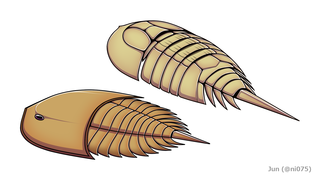
Brontoscorpio is a extinct genus of scorpion. Remains of the only known species, Brontoscorpio anglicus, were discovered in the Lochkovian St. Maughan's Formation.-aged sandstone from Trimpley, Worcestershire. The species was described on the basis of an incomplete single free finger of a right pedipalp (In31405), almost 10 centimetres (3.9 in) long. The complete animal is estimated to have been at least 90 centimetres (3 ft) long. The species is characterized by the presence of single condyle and row of thick tubercles on the pedipalp free finger.

Dolichopterus is a genus of prehistoric sea scorpions, arthropods in the order Eurypterida. Fossils of Dolichopterus have been discovered in deposits ranging from Silurian to Devonian, and have been referred to several different species, some of them of dubious affinity to this genus.
Moselopterus is a genus of prehistoric eurypterid from the Devonian period in Europe. The genus contains three species, M. ancylotelson and M. elongatus from Germany and M. lancmani from Latvia.

Erieopterus is a genus of prehistoric eurypterid found in Silurian to Devonian-aged marine strata of Europe and North America. The genus contains eight species from the Silurian to the Devonian, recovered from both North America and Europe.

Strobilopterus is a genus of prehistoric eurypterid of the family Strobilopteridae. The genus contains four species, two from the Devonian of Wyoming, United States, one from the Devonian of Ohio, United States and one from the Silurian of Estonia.
Tarsopterella is a genus of prehistoric eurypterid classified within the family Hardieopteridae. It contains only one species, T. scotica from the Lower Devonian of Scotland.

Stylonurus is a genus of prehistoric eurypterid of the family Stylonuridae. The genus contains three species: Stylonurus powriensis from the Devonian of Scotland, Stylonurus shaffneri from the Devonian of Pennsylvania and Stylonurus perspicillum from the Devonian of Germany.
Stylonuroides is a genus of prehistoric eurypterid. The genus is classified as a stylonurine but more precise classification has proven difficult, with the genus remaining classified as incertae sedis within the suborder. The genus contains two species, S. dolichopteroides from the Silurian of Ringerike, Norway and S. orientalis from the Devonian of Lake Shunet, Southern Siberia.

Hastimima is a genus of prehistoric eurypterid of the family Mycteroptidae. It contains one valid species, Hastimima whitei, recovered from the Permian Hermit Shale of Arizona, and one dubious species, H. sewardi, from the Devonian of South Africa. Though clearly a mycteropoid eurypterid, the material referred to H. sewardi is so fragmentary that it is questionable if it possesses any diagnostic value at all.

Pagea is a genus of prehistoric eurypterid classified as part of the family Stylonuridae. It contains three species, all from the Devonian; P. plotnicki from Nunavut, Canada and P. sturrocki and P. symondsii from the Old Red Sandstone of the United Kingdom. The genus is named in honor of David Page, an early worker on the fauna of the Old Red Sandstone and describer of the first Stylonurine eurypterid.

Cyamocephalus is a genus of synziphosurine, a paraphyletic group of fossil chelicerate arthropods. Cyamocephalus was regarded as part of the clade Planaterga. Fossils of the single and type species, C. loganensis, have been discovered in deposits of the Silurian period in Lesmahagow, Scotland. Cyamocephalus is one of the two members of the family Pseudoniscidae, the other being Pseudoniscus. Cyamocephalus differ from Pseudoniscus by the fused tergites of 6th and 7th opisthosomal segments.

Eurypteroidea are an extinct superfamily of eurypterids. It contains three families and two genera of uncertain classification, Paraeurypterus and Pentlandopterus.

Pseudoniscidae is an extinct family of synziphosurine chelicerates that lived in the Silurian. Pseudoniscidae is classified inside the clade Planaterga, alongside Bunodidae and Dekatriata. Pseudoniscidae is composed by two genera, Cyamocephalus and Pseudoniscus.

Uraraneida is an extinct order of arachnids, known from fossils of Middle Devonian, Permian and possibly Cretaceous age. Two genera of fossils have been definitively placed in this order: Attercopus from the Devonian of United States and Permarachne from the Permian of Russia. In 2018, a third genus Chimerarachne, from the Cretaceous of Myanmar was proposed to belong to this group, but this placement is disputed. When the first fossils were found, they were identified as spiders, but now constitute the Uraraneida, a separate but closely related group.
Leiopterella is a genus of prehistoric eurypterid of the family Rhenopteridae. It contains one species, Leiopterella tetliei, from the Early Devonian of Nunavut, Canada. The name is said to be derived from the Greek leios and pteros. The proper word for wing in ancient Greek is however pteron (πτερόν). The species name honors Dr. O. Erik Tetlie for his contributions to the study of fossil eurypterids.
Vinetopterus is a genus of prehistoric eurypterid from the Devonian period in Europe classified as part of the Moselopteridae family. The genus contains two species, both from Germany: V. struvei and V. martini.

Borchgrevinkium is an extinct genus of chelicerate arthropod. A fossil of the single and type species, B. taimyrensis, has been discovered in deposits of the Early Devonian period in the Krasnoyarsk Krai, Siberia, Russia. The name of the genus honors Carsten Borchgrevink, an Anglo-Norwegian explorer who participated in many expeditions to Antarctica. Borchgrevinkium represents a poorly known genus whose affinities are uncertain.

Bunodidae is an extinct family of synziphosurine chelicerates that lived in the Silurian. Bunodidae is classified inside the clade Planaterga alongside Pseudoniscidae and Dekatriata. Bunodidae is composed by two genera, Bunodes and Limuloides.
Thurandina is a Devonian genus from Alken, Germany. It was initially described by Leif Størmer as a chelicerate arthropod possibly belonging to the order Eurypterida. Nowadays, it is classified as incertae sedis inside Euchelicerata.












